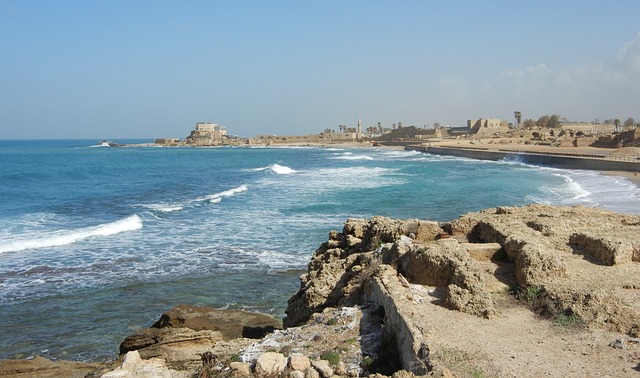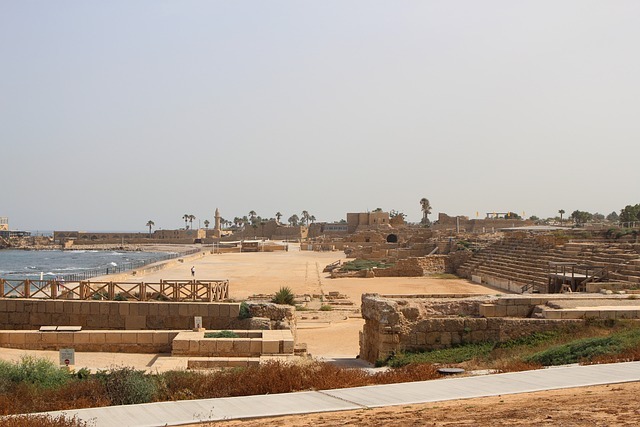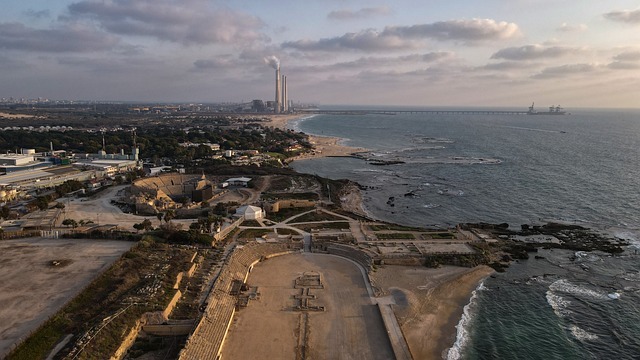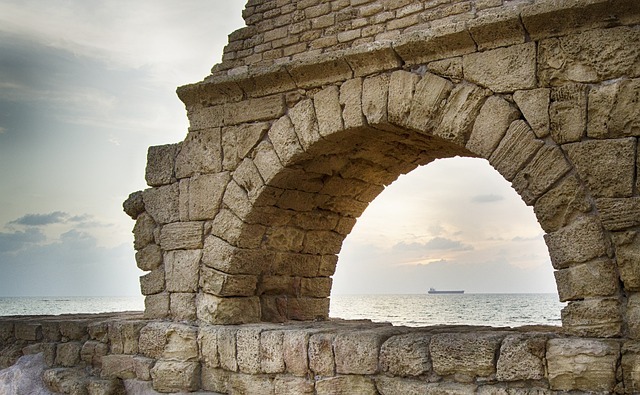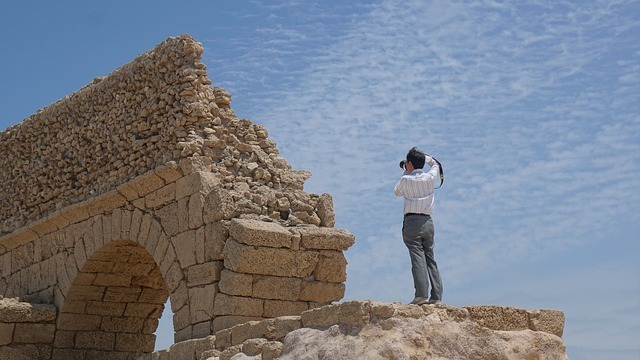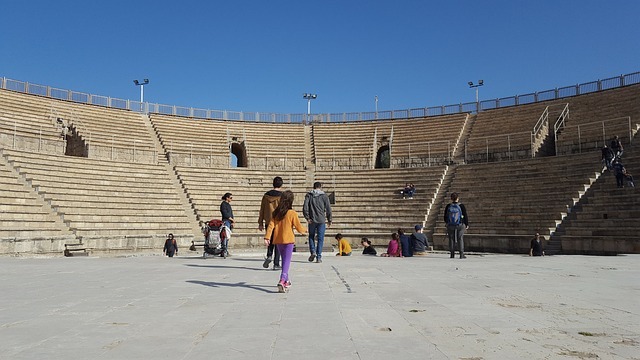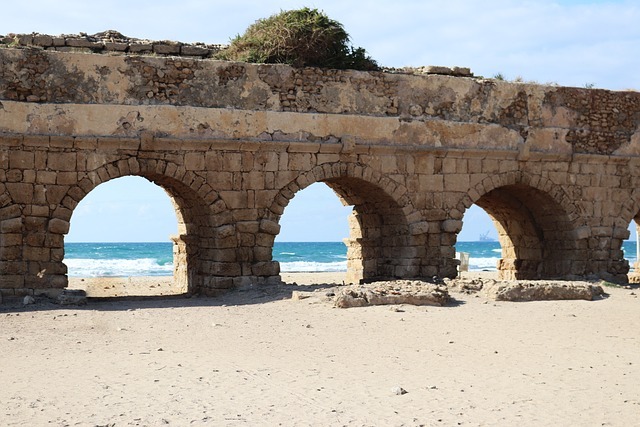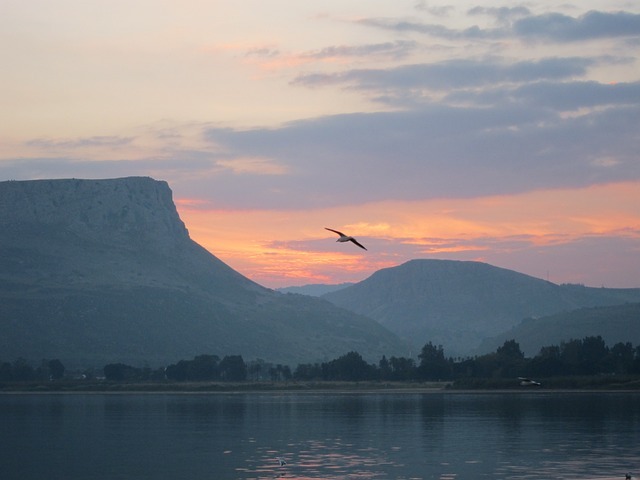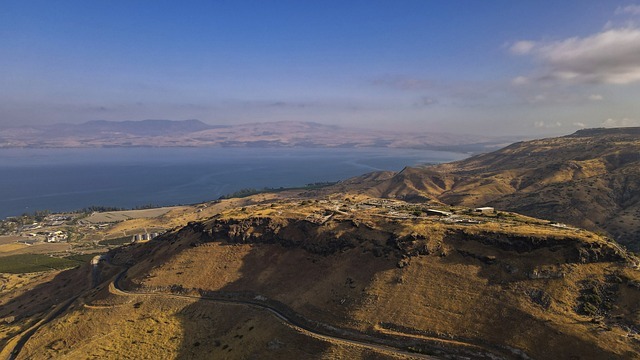CAESAREA FIELD REPORT PART 8
IV.8. The harbor (the Ralli-Museum)
3 pm we are back in the national park to visit the crusaders city. The city was walled in and protected with a moat that was filled with water.
Standing next to the Podium built by Herod, which he artificially raised by constructing retaining walls on top of vaults built beneath, we have to imagine the temple he erected to Augustus.
The temple was surrounded by huge columns with marble from far away.
There were two statues inside, representing Augustus and Rome. Herod made those statues copying the famous statue of Zeus in Olympia, (only 500 years later), and copying the statue of Hera of Samos. He wanted to express his wish to connect himself to those ancient traditions, and make them part of the Roman tradition.
The Temple was knocked down and we can discern the remains of diagonal walls of a church from the 5th century CE found inside the area of the temple. The church was destroyed upon arrival of the Moslem invaders who built on the same site a mosque.
The height of the original temple could be extrapolated through the number of pillars and the distance between them.
In the 13th century at end of where the temple and church had stood, the Crusaders attempted to construct a huge church which eventually collapsed because it was built on the roman vaults and not on solid ground. A smaller chapel was subsequently built there later.
He called the harbor SEBASTOS (the Greek name for Augustus). In building and giving names to his buildings he wanted to give a message to the people and to Rome.
Avner Raban (who has just passed away 10 days ago) excavated the harbor. All dimensions are available now.
We turn towards the sea and face the biggest artificial harbor of the world. Not much can be seen today: the harbor was built on sandy grounds, and in spite all the precautions that Herod took it sank into the sand. Only what was built on rock (kurkar) survived.
However, divers would be able to see a great deal of the foundations of the harbor. Another option today would be by flying over the harbor, whose walls – shape and shade – still can be made out in and under the water
Raban did in fact excavate also under water
The Crusader city was much smaller than the Byzantine city, about 800 Dunams.
The modern harbor is about 1/5 of the size of Herod’s harbor.
We are looking at the top of the harbor where there was the citadel.
The size of the harbor – 200 dunam – was much bigger than the temple mount in Jerusalem which took up 144 dunam.
Lighthouses:
At the entrance of the harbor stood 2 lighthouses. Other harbors with similar lighthouses at approximately the same time were Alexandria and Athens (both harbors were built in a natural bay.) The sandy beach – the sand had shifted north from the Nile-delta – may be great for tourism, but it certainly was and is no good for boats.
In the winter boats had to stay in the harbors since the stormy season would make it impossible for boats to sail. Therefore all boats and their crews arriving before the winter had to stay in Caesarea, needing shelter, which was also a source of income for the population.
Herod built the most beautiful harbor in history.
The harbor could host approx. 100 boats of 500 tons each.
As a result of this new harbor the Nabateans who had used until then the harbor of Ashquelon for shipping their goods, abandoned Ashquelon and used the harbor of Caesarea. This in turn meant that more people would stay during the winter in the city and would also spend more money.
In raising the standard of living but not asking for higher taxes Herod attracted many people to the city.
The harbor of Caesarea was one of the greatest investments of Herod and meant also a new gateway. Formerly only Egypt had such a gateway.
All rulers referred to it who kept its importance until the arrival of Israel who had no interest in the harbor. When the crusaders invaded the area the harbor was revived but on a much smaller scale.
Baybars destroyed the city.
Moslems from Bosnia were brought here by….for shelter (Maagan Michael).
There were about 50 families who built a small town on the ruins of Caesarea.
One of the refugees, Akram Akrugal, became interested in archaeology. He later became head of the archaeological department of the University of Istanbul.
During WWI, a pigeon with message flew into the tower of the Minaret and was uncovered. This led to the discovery of the underground NILI spy ring which was centered in Zichron Yaacov.
BUILDING OF THE HARBOR
In order to achieve the goal of building this artificial harbor he invented something completely new: he was the first builder to use hydraulic concrete to be poured in cracks of bricks that hardened also in water.
Wooden rafts of 15x3x5 m would pull the arriving ships into place.
Wooden double wall into which a mixture of concrete and rubble were poured in. The rafts sank slowly into the water and he also used melted lead for hardening.
Although the walls of the pier were huge 60x800m, Herod did not trust it and built another wall (around it)
The undertaking of building this harbor seems like an unbelievable task and seems almost like a miracle (but it was not included as one of the 7 ancient wonders of the world for the simple reason that it was built 500 years too late (after the accepted list was created).
Part of the concrete that was found is in the museum in Sdot Yam which houses many of the artifacts found in the excavations
The nearby kibbutz rends out boats with a glass bottom.
The obvious question to ask is why did Herod not use the natural port of Haifa? The answer is as simple as well: Haifa was not within his reach – already Dor, which is only 10km north of Caesarea, was not in Herod’s hands.
Most harbors are built on the basis of a natural bay.
We are resting on the lawn: this was the inner part of the port.
V CHRISTIANITY
Christian Connections to Caesarea
Paul: was arrested, but then wanted to be tried as a Roman citizen. He spent time in Caesarea on his way to the trial and subsequent execution in Rome.
Peter, staying in Jaffa with Simon the Tanner had a vision of a white sail with all kinds of unclean (unkosher) animals descending from it. He was then given notice that a Roman officer from Caesarea was interested in conversion. From this vision, comes the concept that Peter accepted Caesarea into Christianity, meaning a turn towards the conversion of pagans and not just working among the Jews.
Cornelius became chrstian and this became a turning point that changed history.
Antioch – disciples Abs. Chapter 10 concerning Caesarea
ORIGEN – originuns:
Bishop of underground Christian community, very knowledgeable, collected all, and translated into Greek = Hexapella, and collected all available translations incl. Septuagint.
Eusebius = Bishop, was arrested because he was Christian. After Constantine legalized Christianity, Eusebius became one of his advisors and one of the most important of the Bishops. He was a prolific writer who wrote some very important works including a Church history and the Onomasticon= book of holy country, geography – basically a gazetteer of the entire country. We have an understanding that the Medaba map was based on Eusebius’ Onomasticon.
During the First century, CE, the power of the Bishops was more or less equal. Susequently, Caesarea remained one of the more important Christian centers, together with Jerusalem.
Talmudic sources on Caesarea:
Rabbi Abu…part of the Jerusalem Talmud was written in Caesarea and
Rabbanan de Caesarium wrote 5th century.
Initially pagan city, Caesarea subsequently became a stronghold for Jews and Christians.
Source in English: Kenneth Hollum: Herod’s dream
Article in National Geographic about lighthouses – copy of one in Alexandria.

